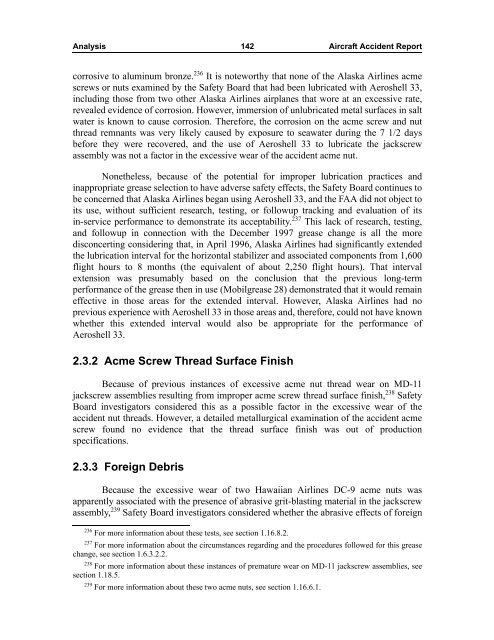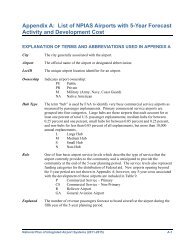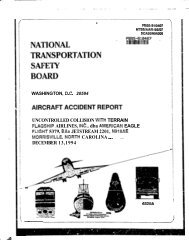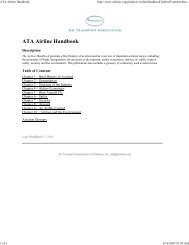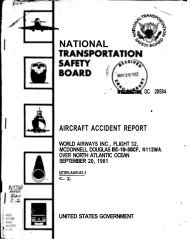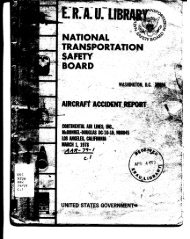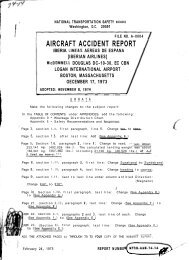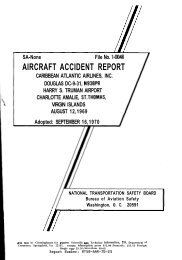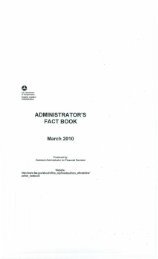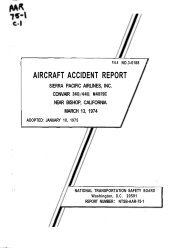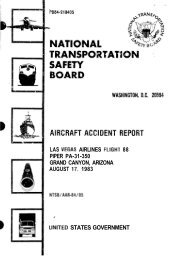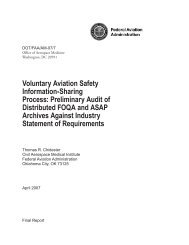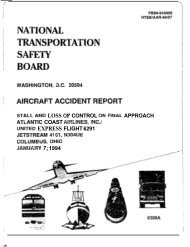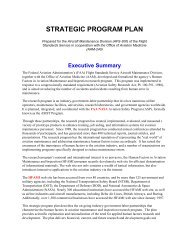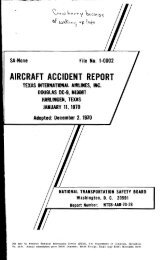NTSB/AAR-02/01
NTSB/AAR-02/01
NTSB/AAR-02/01
You also want an ePaper? Increase the reach of your titles
YUMPU automatically turns print PDFs into web optimized ePapers that Google loves.
Analysis 142 Aircraft Accident Report<br />
corrosive to aluminum bronze. 236 It is noteworthy that none of the Alaska Airlines acme<br />
screws or nuts examined by the Safety Board that had been lubricated with Aeroshell 33,<br />
including those from two other Alaska Airlines airplanes that wore at an excessive rate,<br />
revealed evidence of corrosion. However, immersion of unlubricated metal surfaces in salt<br />
water is known to cause corrosion. Therefore, the corrosion on the acme screw and nut<br />
thread remnants was very likely caused by exposure to seawater during the 7 1/2 days<br />
before they were recovered, and the use of Aeroshell 33 to lubricate the jackscrew<br />
assembly was not a factor in the excessive wear of the accident acme nut.<br />
Nonetheless, because of the potential for improper lubrication practices and<br />
inappropriate grease selection to have adverse safety effects, the Safety Board continues to<br />
be concerned that Alaska Airlines began using Aeroshell 33, and the FAA did not object to<br />
its use, without sufficient research, testing, or followup tracking and evaluation of its<br />
in-service performance to demonstrate its acceptability. 237 This lack of research, testing,<br />
and followup in connection with the December 1997 grease change is all the more<br />
disconcerting considering that, in April 1996, Alaska Airlines had significantly extended<br />
the lubrication interval for the horizontal stabilizer and associated components from 1,600<br />
flight hours to 8 months (the equivalent of about 2,250 flight hours). That interval<br />
extension was presumably based on the conclusion that the previous long-term<br />
performance of the grease then in use (Mobilgrease 28) demonstrated that it would remain<br />
effective in those areas for the extended interval. However, Alaska Airlines had no<br />
previous experience with Aeroshell 33 in those areas and, therefore, could not have known<br />
whether this extended interval would also be appropriate for the performance of<br />
Aeroshell 33.<br />
2.3.2 Acme Screw Thread Surface Finish<br />
Because of previous instances of excessive acme nut thread wear on MD-11<br />
jackscrew assemblies resulting from improper acme screw thread surface finish, 238 Safety<br />
Board investigators considered this as a possible factor in the excessive wear of the<br />
accident nut threads. However, a detailed metallurgical examination of the accident acme<br />
screw found no evidence that the thread surface finish was out of production<br />
specifications.<br />
2.3.3 Foreign Debris<br />
Because the excessive wear of two Hawaiian Airlines DC-9 acme nuts was<br />
apparently associated with the presence of abrasive grit-blasting material in the jackscrew<br />
assembly, 239 Safety Board investigators considered whether the abrasive effects of foreign<br />
236 For more information about these tests, see section 1.16.8.2.<br />
237<br />
For more information about the circumstances regarding and the procedures followed for this grease<br />
change, see section 1.6.3.2.2.<br />
238<br />
For more information about these instances of premature wear on MD-11 jackscrew assemblies, see<br />
section 1.18.5.<br />
239 For more information about these two acme nuts, see section 1.16.6.1.


